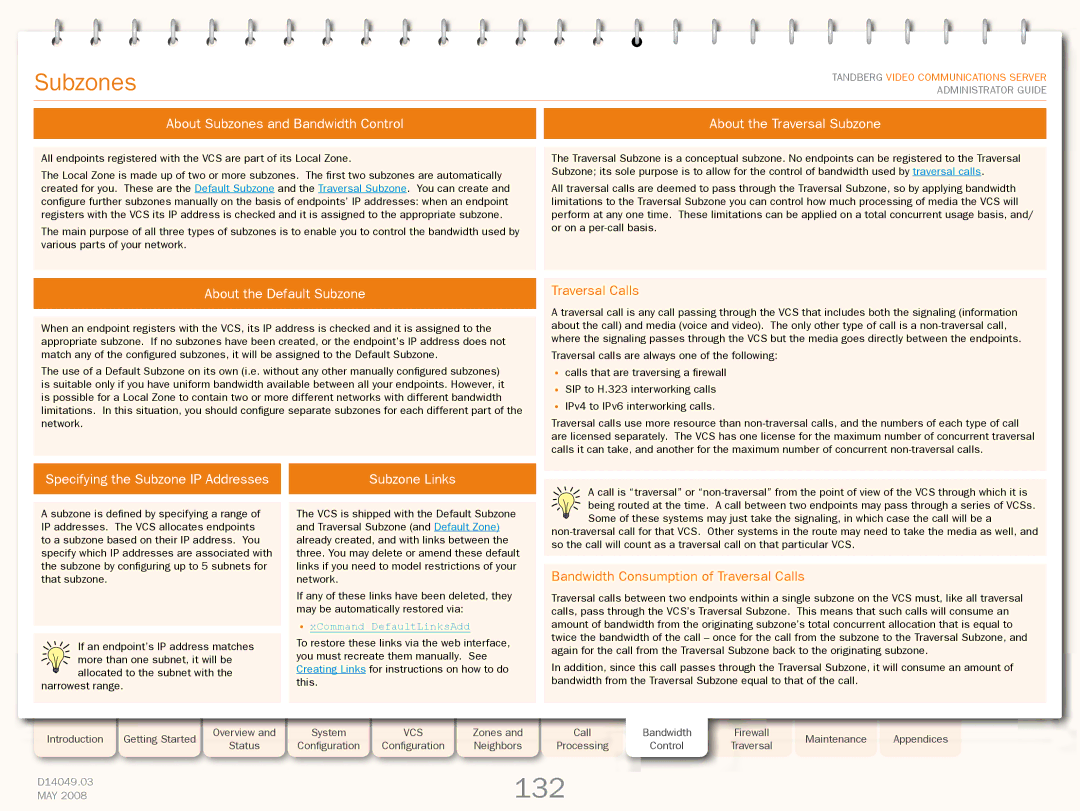
Grey Headline (continued)
Subzones
TANDBERG VIDEO COMMUNICATIONS SERVER ADMINISTRATOR GUIDE
About Subzones and Bandwidth Control |
| About the Traversal Subzone |
|
|
|
All endpoints registered with the VCS are part of its Local Zone.
The Local Zone is made up of two or more subzones. The first two subzones are automatically created for you. These are the Default Subzone and the Traversal Subzone. You can create and configure further subzones manually on the basis of endpoints’ IP addresses: when an endpoint registers with the VCS its IP address is checked and it is assigned to the appropriate subzone.
The main purpose of all three types of subzones is to enable you to control the bandwidth used by various parts of your network.
The Traversal Subzone is a conceptual subzone. No endpoints can be registered to the Traversal Subzone; its sole purpose is to allow for the control of bandwidth used by traversal calls.
All traversal calls are deemed to pass through the Traversal Subzone, so by applying bandwidth limitations to the Traversal Subzone you can control how much processing of media the VCS will perform at any one time. These limitations can be applied on a total concurrent usage basis, and/ or on a
About the Default Subzone
When an endpoint registers with the VCS, its IP address is checked and it is assigned to the appropriate subzone. If no subzones have been created, or the endpoint’s IP address does not match any of the configured subzones, it will be assigned to the Default Subzone.
The use of a Default Subzone on its own (i.e. without any other manually configured subzones) is suitable only if you have uniform bandwidth available between all your endpoints. However, it is possible for a Local Zone to contain two or more different networks with different bandwidth limitations. In this situation, you should configure separate subzones for each different part of the network.
Specifying the Subzone IP Addresses |
| Subzone Links |
|
|
|
Traversal Calls
A traversal call is any call passing through the VCS that includes both the signaling (information about the call) and media (voice and video). The only other type of call is a
Traversal calls are always one of the following:
•calls that are traversing a firewall
•SIP to H.323 interworking calls
•IPv4 to IPv6 interworking calls.
Traversal calls use more resource than
A call is “traversal” or
A subzone is defined by specifying a range of IP addresses. The VCS allocates endpoints to a subzone based on their IP address. You specify which IP addresses are associated with the subzone by configuring up to 5 subnets for that subzone.
If an endpoint’s IP address matches
more than one subnet, it will be
![]() allocated to the subnet with the narrowest range.
allocated to the subnet with the narrowest range.
The VCS is shipped with the Default Subzone and Traversal Subzone (and Default Zone) already created, and with links between the three. You may delete or amend these default links if you need to model restrictions of your network.
If any of these links have been deleted, they may be automatically restored via:
•xCommand DefaultLinksAdd
To restore these links via the web interface, you must recreate them manually. See Creating Links for instructions on how to do this.
being routed at the time. A call between two endpoints may pass through a series of VCSs.
![]() Some of these systems may just take the signaling, in which case the call will be a
Some of these systems may just take the signaling, in which case the call will be a
Bandwidth Consumption of Traversal Calls
Traversal calls between two endpoints within a single subzone on the VCS must, like all traversal calls, pass through the VCS’s Traversal Subzone. This means that such calls will consume an amount of bandwidth from the originating subzone’s total concurrent allocation that is equal to twice the bandwidth of the call – once for the call from the subzone to the Traversal Subzone, and again for the call from the Traversal Subzone back to the originating subzone.
In addition, since this call passes through the Traversal Subzone, it will consume an amount of bandwidth from the Traversal Subzone equal to that of the call.
Introduction | Getting Started |
| Overview and |
| System |
| VCS |
| Zones and |
| Call | Bandwidth | Firewall |
| Maintenance |
| Appendices |
| Status |
| Configuration |
| Configuration |
| Neighbors |
| Processing | Control | Traversal |
|
| ||||
|
|
|
|
|
|
|
|
|
|
| |||||||
|
|
|
|
|
|
|
|
|
|
|
|
|
|
|
|
|
|
D14049.03 |
|
|
|
|
|
|
|
| 132 |
|
|
|
|
|
| ||
MAY 2008 |
|
|
|
|
|
|
|
|
|
|
|
|
|
| |||
